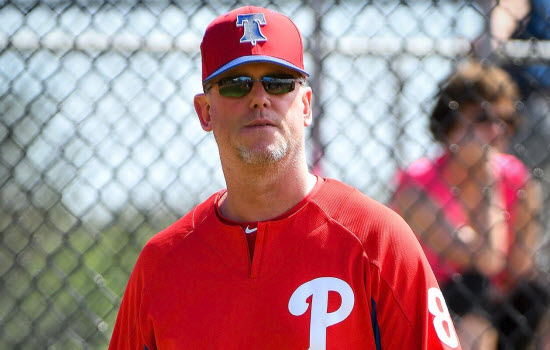Mallee’s numbers tell story about Phillies’ bats

Hitting coach uses statistical data to identify, strengthen weaknesses at plate
By Todd Zolecki MLB.com @ToddZolecki
March 5th, 2018
CLEARWATER, Fla. — Before John Mallee ever stepped into a batting cage with a Phillies hitter, he knew him.
He knew his strengths and weaknesses. He knew his tendencies. Mallee knew these things because after the Phillies hired him as their hitting coach in November, he dug deep into the numbers.
“A lot of times through the data you can kind of tell who they are,” Mallee said. “What is their behavior? What is their approach? Is he a first-pitch swinger? How often are those pitches in the zone? Is that something we need to make an adjustment on early in the count? What is his production with two strikes? Over 50 percent of your at-bats are going to be with two strikes.”
Mallee, 48, spent the previous three seasons with the Cubs, following stints with the Astros and Marlins. The Cubs and Astros believe in the power of information, and the Phillies are no different.
In that sense, Mallee seemed like a natural fit to join Phillies manager Gabe Kapler’s staff. Mallee performed his own research, then asked the research and development department for its take, essentially confirming or refuting what he found.
“I don’t want to make any bad decisions, because I don’t want to be coaching them the wrong way,” Mallee said. “We can look at certain guys with high ground-ball rates and different things, and say we need to get the ball off the ground. OK, how do we do that? What’s causing it? Is it an approach thing? Is it a mechanical thing? So understanding the metrics of each, the analytics of it all, and then trying to match that up with the mechanics and the approach.”
Take Maikel Franco. The average MLB hitter swung at the first pitch 28.6 percent of the time last season, but Franco swung at the first pitch 39.5 percent of the time to rank 24th out of 350 hitters (with 200 or more plate appearances). But just 72.1 percent of Franco’s first-pitch swings were at pitches in the strike zone, below the league average (76.7 percent).
The average batter also hit .176 in with two strikes and .279 against fastballs, but Franco hit .138 and .252, respectively.
Only two other hitters in baseball saw a higher rate of sliders than Franco (24 percent). Pitchers threw Franco sliders because he swung and missed them a lot. A little more than 40 percent of Franco’s total swings-and-misses last season came against sliders, the highest rate among 154 hitters (minimum 200 whiffs).
Mallee can take that information and formulate a plan to improve Franco’s mechanics and approach at the plate.
“Once you identify what his issues are and where he makes his outs, what pitches or locations, then you go to the mechanics and try to see if there’s something physically that doesn’t allow him to cover that area or that zone,” Mallee said.
Franco had an open stance last season, with his front foot pointing toward third base. But now Franco’s front foot is pointing toward the mound, which he hopes will provide better plate coverage.
Then there is Franco’s approach.
“Our whole philosophy of selective, aggressive hitting is our guys are going to attack pitches they can drive early in the count and take everything else within the strike zone, even if it’s a strike,” Mallee said. “Wherever their strengths are, they’re going to look in there. If the ball shows up there they’re going to swing, but if it doesn’t that’s how they work counts as opposed to taking pitches. We’re looking for something to slug until the count tells us we have to change our behavior. The count tells us that when we get to two strikes. Now I have a different approach for that.
“We try to keep it as simple plan as possible. It’s almost like see it and hit it, but it’s see it where and hit it.”
